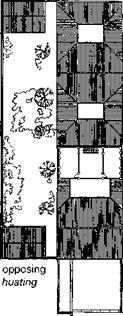Chinese gardens have a long history, which can be roughly divided into two categories: the Imperial forbidden gardens, or Imperial yuanlin, and private residential pleasure gardens of scholars, government officials, regional governors and merchants, or private yuanlin, which developed from the ting yuan.
Most Imperial yuanlin were royal pleasure parks linking the Imperial palace to detached palaces. They were sometimes built around natural mountains and rivers with a certain amount of remodeling, and at other times constructed completely from man-made excavations—but in either case they were splendid grounds, built on a vast scale. Private yuanlin were built within or on the outskirts of cities, near residences, and were intended exclusively for enjoyment.
The features of the relatively small spaces of private yuanlin were minutely detailed; they represented a distillation of the garden-making techniques cultivated in Imperial gardens. The development of the modern urban private yuanlin has its roots in the ting yuan, an earlier interpretation of the Imperial yuanlin prototype.
Imperial Y uanlin
Chinese gardens had already taken form over 2000 years ago, as evidenced in recorded descriptions of the gardens
 |
 |
 |
 |
of E-fang Palace (constructed 213 b. c.) of the first Qin emperor, Shi Huang, and the garden of Han emperor Wu, known as Shang-ling yuan (constructed 138 B. c.).
Shang-ling yuan encompassed more than 300 li (a Chinese mile, roughly one-third an English mile, or half a kilometer), had six lakes, over 70 detached palaces, 3,000 varieties of flowering trees, and was stocked with “creatures from all over the world.” Hunting parties were held within the Shang-ling yuan grounds. Both it and the gardens of E-fang Palace were ultimately based on spiritu – al/magical beliefs in the shen xian, or Taoist Immortals, whose mist-covered dwelling-places on mountains and islands these gardens were intended to recall.
These Chinese gardens, which borrowed from the natural landscape to express ideological, religious, and literary concepts were profoundly influential as prototypes for later Chinese gardens, as well as for other Oriental—and particularly Japanese—gardens.



